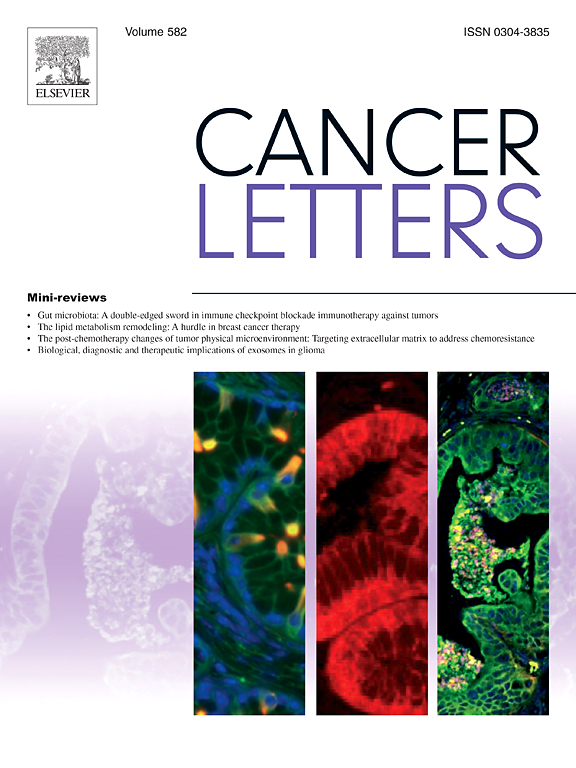Combination nitazoxanide and auranofin treatment has synergistic anticancer activity in anaplastic thyroid cancer through enhanced activation of oxidative stress that leads to apoptosis
IF 10.1
1区 医学
Q1 ONCOLOGY
引用次数: 0
Abstract
Anaplastic thyroid cancer (ATC) has one of the highest mortality rates of all human malignancies and has no cure. We used combination drug matrix screening of highly active compounds and identified that combination of nitazoxanide and auranofin was one of those with the highest synergistic anticancer activity. We investigated its synergistic anticancer activity and mechanism of action in preclinical ATC models. We performed in vitro, ex vivo, and in vivo ATC models to evaluate the synergistic anticancer activity and the mechanism of action of this combination. Combination nitazoxanide and auranofin treatment synergistically inhibited cellular proliferation, colony formation, and cellular migration compared to control and single agents. Combination treatment also significantly reduced ATC cell line and patient-derived ATC spheroid size. Nitazoxanide alone and in combination with auranofin caused ER stress and apoptosis. Auranofin alone and in combination with nitazoxanide induced activation of the ROS generating pathway. This led to enhanced increase in ROS and MDA levels with combination treatment associated with upregulation of HMOX-1 and cell death that was reversed by N-acetyl cysteine (NAC). The combination significantly inhibited tumor growth in vivo in 8505C ATC cells, and C643 ATC cells, without significant treatment-related toxicity. Combination nitazoxanide and auranofin treatment has synergistic anticancer activity in vitro, ex vivo, and in vivo in ATC, which is due to enhanced oxidative stress and induction of apoptosis compared to single-drug treatment. Both drugs are FDA approved; their combination is a potential candidate for evaluation in a clinical trial for ATC therapy.
nitazoxanide和auranofin联合治疗通过增强氧化应激激活导致细胞凋亡,在间变性甲状腺癌中具有协同抗癌活性。
间变性甲状腺癌(ATC)是所有人类恶性肿瘤中死亡率最高的疾病之一,而且无法治愈。我们使用联合药物基质筛选高活性化合物,并确定nitazoxanide和auraurofin的组合是具有最高协同抗癌活性的化合物之一。我们在临床前ATC模型中研究了其协同抗癌活性和作用机制。我们通过体外、离体和体内ATC模型来评估该组合的协同抗癌活性和作用机制。与对照和单一药物相比,nitazoxanide和auraurofin联合治疗可协同抑制细胞增殖、集落形成和细胞迁移。联合治疗也显著降低ATC细胞系和患者源性ATC球体大小。Nitazoxanide单独和联合auraurofin引起内质网应激和细胞凋亡。单独或联合硝唑尼特可诱导ROS生成途径的激活。这导致ROS和MDA水平增加,联合治疗与HMOX-1上调和n -乙酰半胱氨酸(NAC)逆转的细胞死亡相关。该组合在体内显著抑制8505C ATC细胞和C643 ATC细胞的肿瘤生长,无明显的治疗相关毒性。nitazoxanide和auraurofin联合治疗ATC在体外、体内和体外均具有协同抗癌活性,这是由于与单药治疗相比,nitazoxanide和auraurofin联合治疗增强了氧化应激和诱导细胞凋亡。这两种药物都是FDA批准的;它们的组合是ATC治疗临床试验评估的潜在候选者。
本文章由计算机程序翻译,如有差异,请以英文原文为准。
求助全文
约1分钟内获得全文
求助全文
来源期刊

Cancer letters
医学-肿瘤学
CiteScore
17.70
自引率
2.10%
发文量
427
审稿时长
15 days
期刊介绍:
Cancer Letters is a reputable international journal that serves as a platform for significant and original contributions in cancer research. The journal welcomes both full-length articles and Mini Reviews in the wide-ranging field of basic and translational oncology. Furthermore, it frequently presents Special Issues that shed light on current and topical areas in cancer research.
Cancer Letters is highly interested in various fundamental aspects that can cater to a diverse readership. These areas include the molecular genetics and cell biology of cancer, radiation biology, molecular pathology, hormones and cancer, viral oncology, metastasis, and chemoprevention. The journal actively focuses on experimental therapeutics, particularly the advancement of targeted therapies for personalized cancer medicine, such as metronomic chemotherapy.
By publishing groundbreaking research and promoting advancements in cancer treatments, Cancer Letters aims to actively contribute to the fight against cancer and the improvement of patient outcomes.
 求助内容:
求助内容: 应助结果提醒方式:
应助结果提醒方式:


